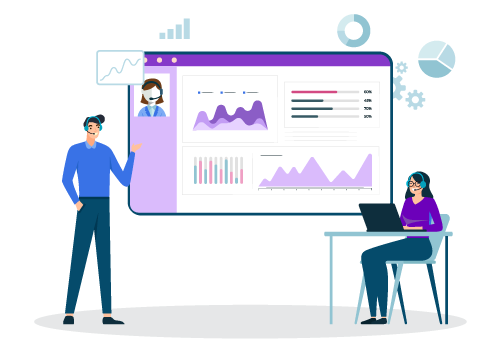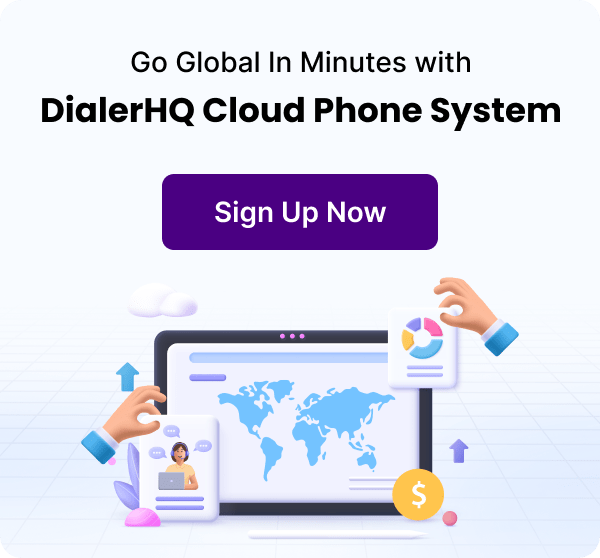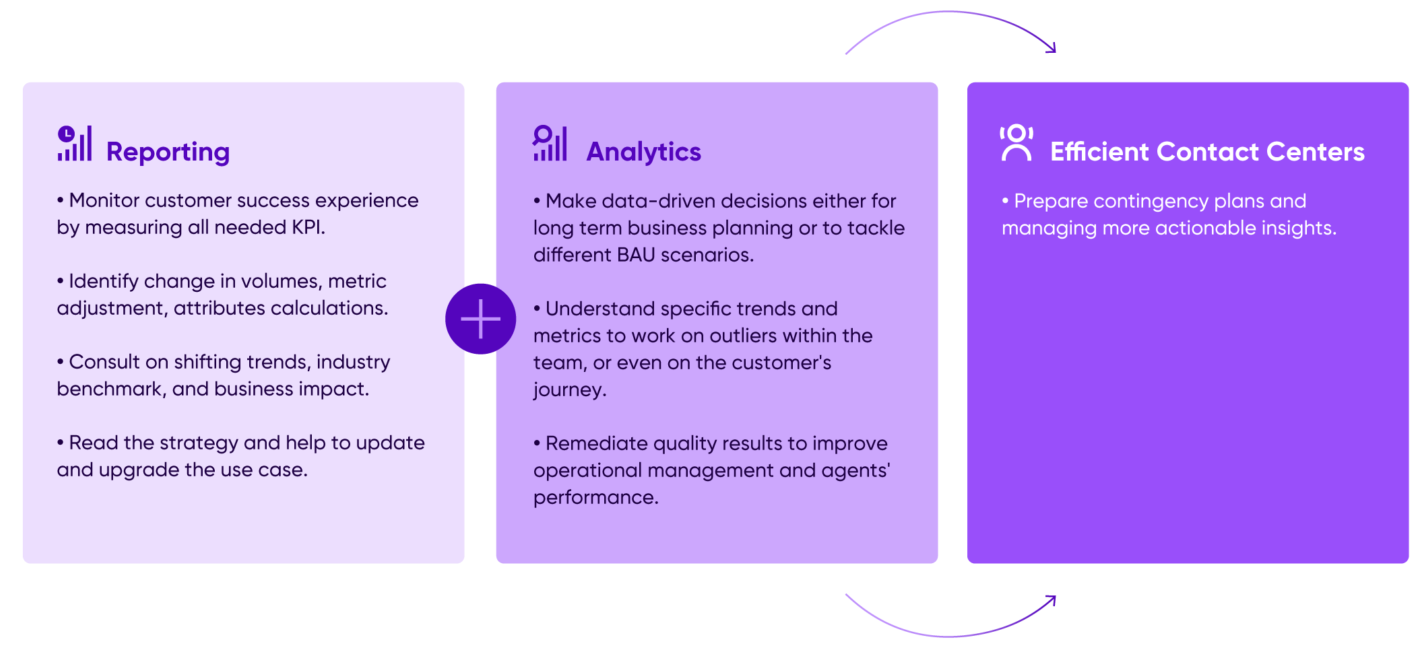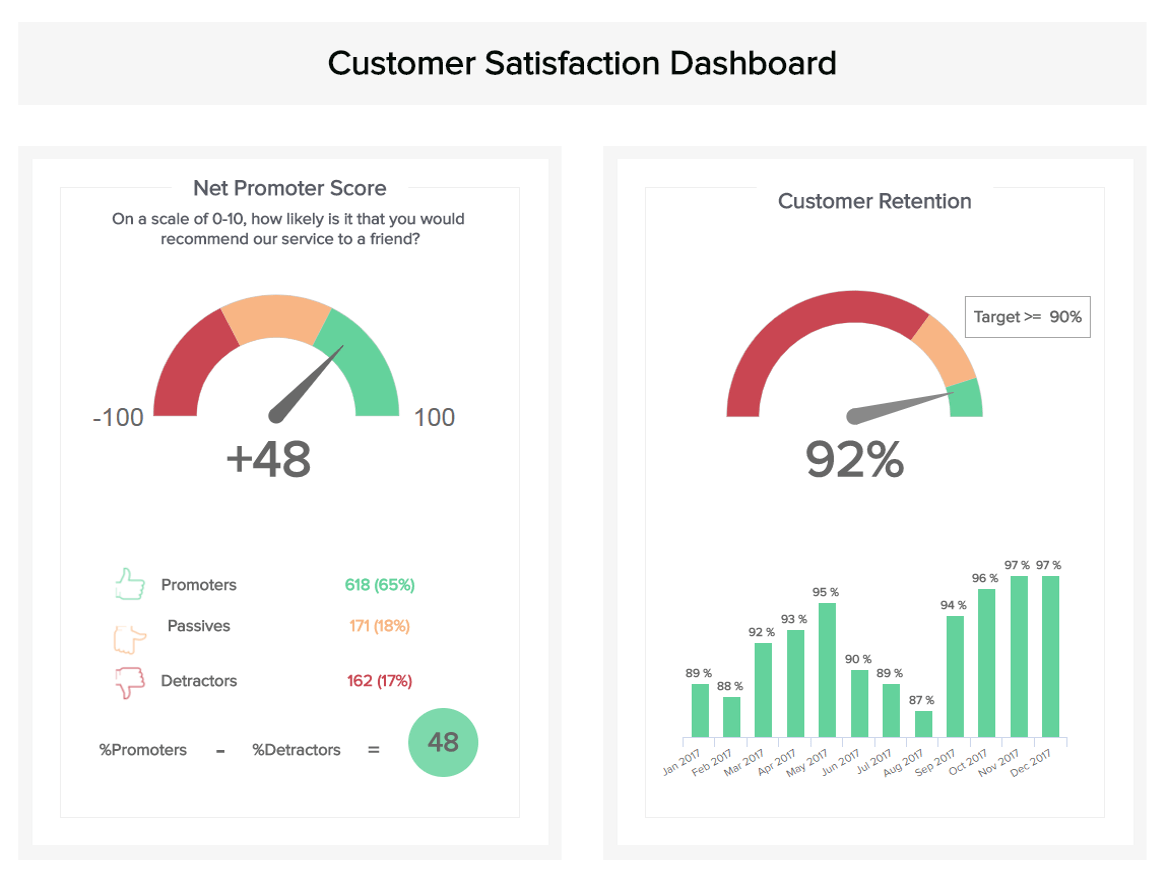Senior Writer: Rohit Rajpal
Call centers keep customers happy and increase their average lifetime value (CLV). According to a study, 86% of buyers are willing to pay more for a great customer experience. According to the same study, 72% of customers share a positive experience with 6 or more people; if they are unhappy, 13% will share their experience.
But how do you know if your customers are happy with your service? The answer is in your contact center performance. And if you’re not sure how the call center reporting process works or the metrics you should measure, you’re in the right place.
In this blog, we’ll discuss what call center reporting is, the problems with the current system, its benefits, and the top ten KPIs. We’ll also discuss the difference between call center reporting and analytics. Let’s get started!
Focus on creating a customer-centric culture where empathy and personalized service are valued. Invest in training and development to empower your agents to deliver exceptional customer experiences. Remember that behind every call is a human being, and building strong relationships should be the ultimate goal of your call center operations.
What is Call Center Reporting?
Call center reporting refers to collecting, analyzing, and interpreting data related to call center operations. It involves tracking and measuring key metrics and performance indicators to gain insights into customer interactions’ efficiency, effectiveness, and quality within the call center.
By monitoring and analyzing data such as call volume, response times, agent performance, customer satisfaction, and other relevant metrics, call center reporting helps optimize resources, enhance customer experiences, and achieve business objectives.
Call center reporting typically involves generating regular reports summarizing the collected data clearly and meaningfully. These reports provide a snapshot of the call center’s performance, identify trends, highlight strengths and weaknesses, and facilitate data-driven decision-making.
Call Center Reporting KPIs
The most beneficial call center report helps to customize your call or contact center. This report provides some insights into the most important indicators of success and high performance for your business.
Let’s have a look at some “business, customer, process critical KPIs” to build your call center reporting.
Business Critical KPIs
| Business Critical KPIs | Global Benchmark |
|---|---|
| Net Promoter Score (NPS) | Varies significantly between industries |
| Average Turnover Rate | Less than 37% (source: observe) |
| Cost Per Contact | $5.50 (source: liveagent) |
| Agent Engagement Score | 30% highly engaged, 11% somewhat engaged, and 5% highly disengaged (source: sqmgroup) |
Customer Critical KPIs
| Customer Critical KPIs | Global Benchmark |
|---|---|
| First Contact Resolution (FCR) | 70-75% (source: liveagent) |
| Service Level | Most commonly, 80% of calls answered within 20 seconds = 80/20 (source: cloudtalk) |
| Average Abandonment Rate | 5-8% (source: cloudtalk) |
| Blocked Calls | Less than 2% (source: observe) |
| Average Wait Time (AWT) | Around 45 seconds (source: ozonetel) |
Process Critical KPIs
| Process Critical KPIs | Global Benchmark |
|---|---|
| Average Speed to Answer | 34.4 seconds (source: liveagent) |
| Average Call Duration | Four minutes (source: cloudtalk) |
| Call Arrival Rate | Will vary from one call center to the next (source: cloudtalk) |
| Average Handle Time (AHT) | Six minutes (source: liveagent) |
| Average After-Call Work Time (ACW) | 40-45 seconds (source: ozonetel) |
Types of Call Center Reports
There are three major types of call center reports: agent-related reports, call center-related reports, and customer-related reports. Let’s understand each call center report in detail.
Agent-related reports focus on individual agent performance and provide insights into their productivity, efficiency, and quality of customer interactions. It helps evaluate agent adherence to schedules, handle time, and customer satisfaction ratings.
Key metrics tracked in agent-related reports may include average handle time, average speed to answer, average call duration, first call resolution, agent occupancy, and average turnover rate. These reports aid in identifying top-performing agents, improvement areas, and overall agent productivity.
Call center-related reports provide a broader view of the call center’s performance. They focus on metrics related to overall call center operations, resource utilization, and service levels.
Contact center reports may include call volume, service level agreements (SLAs), average wait time, average abandonment rate, call forecasting accuracy, and call center efficiency. Call center-related reports enable managers to assess the call center’s performance against targets, optimize staffing levels, and ensure efficient operations to meet service-level goals.
Customer-related reports help understand what customers think of your service. These reports provide insights into customer preferences, pain points, and trends, enabling organizations to tailor their services, address issues promptly, and enhance customer satisfaction.
Metrics commonly tracked in customer-related reports include customer satisfaction scores (CSAT), net promoter score (NPS), customer feedback, customer complaints, and customer retention rates.
Problems with Current Reporting Systems
Current reporting systems in call center software may face several challenges that hinder their effectiveness and limit their ability to provide accurate and meaningful insights. Some common problems with current reporting systems include:

1. Data Inaccuracy
Reporting systems heavily rely on accurate and reliable data. However, data inaccuracies, such as missing or incorrect information, can compromise the integrity and validity of the reports. Inconsistent data entry, manual errors, and system glitches can contribute to data inaccuracies.
2. Lack of Real-time Reporting
Traditional reporting systems often generate reports with a delay, making it difficult to monitor call center performance in real-time. This delay prevents the timely identification of issues and limits the ability to take immediate corrective actions.
You May Also Read : What is Call Center Monitoring and Why is it Important?
3. Limited Customization
Many current reporting systems offer limited flexibility for customizing reports based on specific business needs. Call centers may require different report formats, metrics, and visualizations to align with their unique goals and objectives.
4. Insufficient Drill-down Capabilities
Call center reporting solutions may lack the ability to drill down into granular details of the data. This limitation makes it challenging to investigate specific issues, identify root causes, and uncover actionable insights for improvement.
5. Complex Data Integration
Call center operations involve multiple systems and data sources, such as customer relationship management (CRM) platforms, call management system, telephony systems, and workforce management tools. Integrating data from these disparate sources into a cohesive reporting system can be complex and time-consuming.
6. Lack of Contextual Insights
Raw data alone may not provide sufficient context to interpret and understand the factors impacting call center performance. Without contextual insights, it becomes challenging to identify the reasons behind certain trends or make informed decisions based on the data.
Addressing these problems requires implementing advanced call center reporting tools that leverage automation, real-time data capture, customization options, intuitive visualizations, and robust data integration capabilities.
Call Center Reporting vs. Call Center Analytics
Call center reporting primarily focuses on collecting, analyzing, and presenting key metrics and performance indicators related to operations. It involves tracking and reporting on call volume, average wait time, service level, agent performance, customer satisfaction, and more.
On the other hand, call center analytics goes beyond the surface-level metrics and delves into more advanced analysis and insights. It involves applying statistical and predictive modeling techniques to uncover patterns, correlations, and predictive trends within the call center data.
In other words, contact center reporting provides a snapshot of current performance, highlights trends, and identifies areas for improvement. Whereas call center analytics answers more complex and strategic questions, such as identifying the root causes of customer issues, predicting call volumes and staffing requirements, optimizing resource allocation, and identifying opportunities for process improvements.
5 Benefits of Call Center Reporting
The five key benefits of call center reporting are performance monitoring, identifying trends & patterns, quality assurance & training, real-time decision-making, and enhancing customer experience. Let’s understand these benefits of contact center reporting in detail.
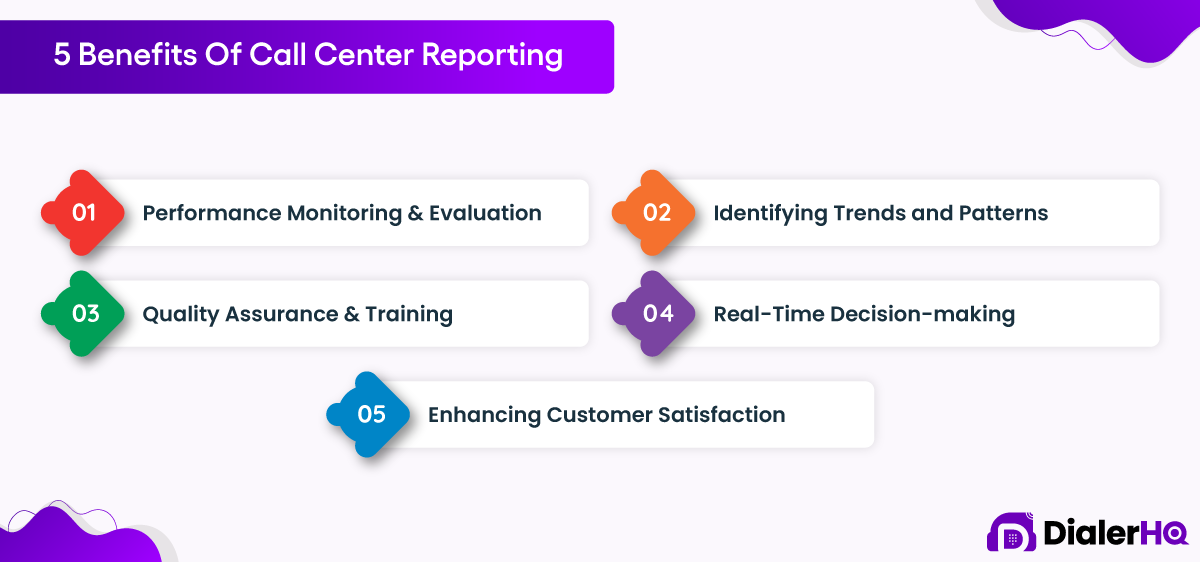
1. Performance Monitoring and Evaluation
Call center reporting allows managers and supervisors to monitor and evaluate the call center’s performance closely. By tracking key metrics and performance indicators, such as call volume, average wait time, first call resolution, and customer satisfaction, organizations can assess their performance against set targets, identify areas for improvement, and make data-driven decisions to enhance overall efficiency.
2. Identifying Trends and Patterns
Effective call center management reports enable you to identify trends and patterns within the data. By analyzing historical data, organizations can uncover patterns related to call volumes, peak hours, customer issues, and agent performance. This information helps in strategic planning, resource allocation, and proactive decision-making to optimize call center operations.
3. Quality Assurance and Training
Call center reporting provides insights into the quality of customer interactions. Organizations can identify areas where agents may require additional training or support by analyzing metrics like average call duration, call transfers, and customer feedback. This helps improve agent performance, enhance customer experiences, and maintain consistent service quality.
4. Real-time Decision-making
With real-time call center reporting, managers and supervisors can access up-to-date information on call volumes, wait times, and service levels. This enables them to make informed decisions on staffing, call routing, and resource allocation, ensuring efficient operations and improved real-time customer satisfaction.
5. Enhancing Customer Satisfaction
Call center reporting is crucial in enhancing customer satisfaction. Organizations can identify pain points, improve response times, and provide a more seamless and personalized customer experience by tracking first-call resolution, average hold time, and customer feedback metrics. This, in turn, leads to higher customer satisfaction, increased loyalty, and a positive brand reputation.
Top 10 Call Center Reporting KPIs
You can measure performance by tracking the right call center reporting metrics. Here are the top ten call center reporting KPIs that can help.
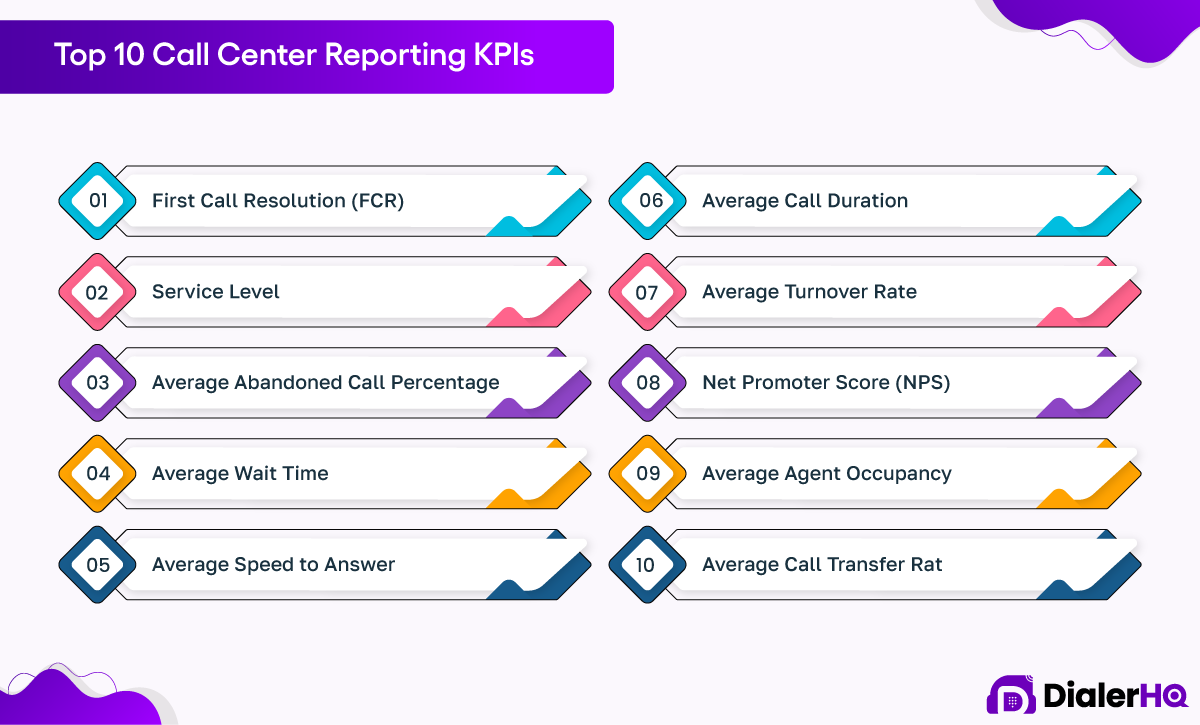
1. First Call Resolution (FCR)
FCR measures the percentage of customer inquiries resolved on the first call with the contact center. It reflects the call center’s ability to efficiently address customer needs, reduce call volumes, and enhance customer satisfaction.
2. Service Level
Service level measures the percentage of calls answered within a specific time frame. It sets the benchmark for call center responsiveness and ensures that customers don’t experience excessive wait times. Common service level targets include answering 80% of calls within 20 seconds or similar criteria.
3. Average Abandoned Call Percentage
This metric represents the percentage of calls that customers abandon before reaching an agent. A high abandoned call percentage indicates potential wait times, call routing, or customer frustration issues. You must keep the abandoned call percentage as low as possible.
You May Also Read : What is Call Abandonment Rate & How to Calculate It?
4. Average Wait Time
Average wait time measures the average time customers spend waiting in the queue before connecting with an agent. It directly impacts customer satisfaction and is crucial for managing call center resources effectively.
5. Average Speed to Answer
Average speed to answer measures the average time it takes for calls to be answered by agents after being routed to them. A low average speed to answer indicates efficient call routing and helps meet service-level targets.
6. Average Call Duration
This metric tracks the average duration of customer calls. It provides insights into call complexity, agent efficiency, and resource allocation. Analyzing average call duration helps identify opportunities to reduce call handling time and improve overall productivity.
7. Average Turnover Rate
The average turnover rate measures the rate at which agents leave the call center. High turnover rates can lead to decreased productivity, increased training costs, and lower customer satisfaction. Tracking this metric helps identify areas for agent retention and engagement improvement.
8. Net Promoter Score (NPS)
NPS measures customer satisfaction and the likelihood of recommending the call center to others. It is determined through customer surveys and provides insights into the overall customer experience.
9. Average Agent Occupancy
Agent occupancy measures the percentage of time agents spend handling calls or engaging in productive activities. High agent occupancy indicates efficient resource utilization, while low occupancy may suggest overstaffing or underutilization.
10. Average Call Transfer Rate
This metric tracks the percentage of calls transferred to another agent or department. A high call transfer rate can indicate inefficient call resolution processes or inadequate agent training.
Wrapping Up
Call center reporting is critical to measure customer satisfaction and identify improvement areas. It also helps make strategic decisions in real-time. However, measuring the right contact center reporting metrics is critical to get the best results from your efforts. Also, divide the reports into agent-related, call center-related, and customer-related metrics to convert them into actionable insights.
FAQs
A call center dashboard visually represents call center metrics and key performance indicators (KPIs) displayed in one place. It provides real-time and historical data to call center managers and agents, allowing them to monitor performance, identify trends, and make data-driven decisions. A call center dashboard typically includes metrics like call volume, average wait time, service level, and agent occupancy. However, you can customize it to meet your requirements.
center's size, call volume, quality assurance objectives, and available resources. However, a common practice is to analyze 8-10 calls from each agent monthly.
Here are some tips for efficient call center reporting:
- Identify relevant KPIs: Determine the metrics that align with your call center's goals. Focus on metrics that provide actionable insights and help measure performance accurately.
- Use real-time rporting: Implement real-time reporting capabilities to monitor call center performance. Real-time data allows managers to identify issues promptly and make immediate adjustments if needed.
- Automate reporting processes: Manual reporting is time-consuming and prone to errors. Consider automating the reporting process using call center software or dedicated reporting tools. It saves time, improves accuracy, and enables data analysis more efficiently.
- Customize reports: Tailor your reports to meet your call center's needs. Different stakeholders may require different types of reports, so customize the format, layout, and level of detail accordingly.
- Regularly review and improve: Review your reports, identify trends, spot areas for improvement, and take action based on the findings.
According to Call Center Magazine, the average hold time for a call center is six minutes and ten seconds. However, it can vary depending on the number of calls you receive and the average call handling time.
Rohit Rajpal simplifies intricate technical ideas into practical insights through his articles and publications. His journey in VoIP and cloud telephony reflects a profound grasp of the evolving landscape, a flair for innovation, and a dedication to creating user-friendly blogs. Rohit’s broad expertise encompasses VoIP protocols, codecs, and cloud-based telephony systems, ensuring accessible knowledge for all.
Updated : May 14, 2024

Subscribe to our newsletter & never miss our latest news and promotions.
